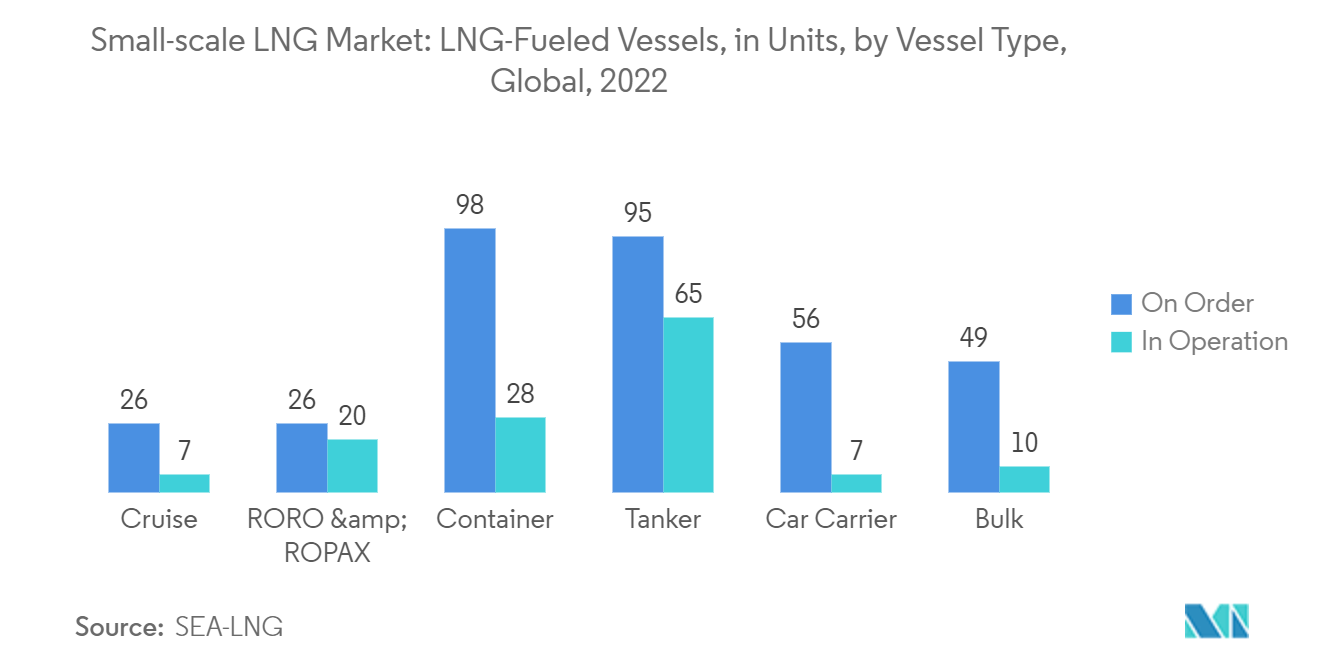Market Trends of Small-scale LNG Industry
Transportation Segment Expected to Dominate the Market
- LNG is primarily used to fuel trucks and ships, mainly due to its economic and environmental benefits, as compared to diesel and fuel oil. Since LNG is non-corrosive and non-toxic in nature, it can extend the life of a vehicle by up to three times. Moreover, since LNG has an extremely low boiling point, very little heat is required to convert it into a gaseous form at high pressure, with negligible mechanical energy. This makes LNG an efficient fuel for transportation.
- Handling LNG is an immense task since even a slight difference in the temperature can lead to the boiling and vaporization of fuel, which, in turn, leads to fuel wastage. Therefore, it makes passenger cars far less viable than heavy vehicles, such as commercial trucks. This has limited the application of LNG in the transportation segment.
- The use of LNG as a transportation fuel is gaining momentum across the world. China, the United States, and Europe have already started deploying LNG-powered trucks, mainly for long-distance freight carriage. This is mainly due to the government policies and regulations on decarbonizing and emission control, such as China VI and European Green Deal.
- Formed in 2019 by the European Commission, the European Green Deal is a set of policy initiatives with an aim to make Europe carbon-neutral by 2050. The policies briefly underline the importance of LNG in reaching the aim, and they emphasize the usage of LNG as fuel for trucks and marine vessels.
- According to SEA-LNG, as of February 2022, there were 137 LNG-fueled ships in operation, and 350 LNG-fueled ships were on order. The rapidly growing order book for LNG-fuelled vessels has witnessed rapid growth compared to previous years and increasing numbers of ship owners and operators apprehend LNG's environmental and climate benefits.
- In January 2020, the International Maritime Organization began implementing a new regulation by placing a 0.5% global sulfur cap on marine fuels. Thus, LNG has become a more viable option as a marine fuel since it emits almost 90% lower NOx and virtually no SOx and particulate matter in comparison to the existing petroleum-based marine fuel oils. Therefore, in this clean air initiative, LNG will play a key role. This will also have a significantly positive impact on the small-scale LNG market.
- New emerging economies are also planning to lay foundation for the future of LNG for transportation. For instance, in April 2022, Mitsui O.S.K. Lines (MOL) plans to launch 110 net zero emission oceangoing vessels by 2035. In addition to promoting the wide adoption of clean energy, the Japanese carrier plans to launch 90 LNG-powered vessels by 2030 as part of its goal to promote widespread adoption of clean energy.
- Hence, owing to the above-mentioned factors, the demand for small-scale LNG infrastructure for the transportation segment is likely to grow and significantly dominate the market during the forecast period.

Asia-Pacific to Dominate the Market
- Asia-Pacific, in recent years, has been a pioneer in the implementation of small-scale LNG projects across the globe. Interest in the use of small-scale LNG (SSLNG) has increased in recent years, as the demand for natural gas continues to increase in countries like China, India, Singapore, Japan, and others.
- As of 2021, China is one of the major countries in the world that led to the growth in LNG demand. The LNG import was around 64.4 million tons in 2022. Due to this surge in demand, China became the one of the world's largest LNG importer. The increased demand is due to Chinese LNG buyers signing long-term contracts for more than 20 million tons a year.
- China's natural gas market includes domestic production and import via pipelines and LNG terminals. In China, the rising demand for small-scale LNG is from industrial, residential, and power generation sectors, with the highest potential being in the transportation sector. Growth in the number of LNG trucks due to the higher price of diesel, as compared to natural gas, is expected to be the prime reason for which small LNG facilities are growing in China.
- While in India, Small-scale LNG is in a very nascent stage, however, there are a few LNG stations, for which LNG transportation through LNG trucks is taking place. With the intention of increasing the share of natural gas to 15% in its energy mix by 2030, India is likely to construct small-scale LNG facilities for natural gas supply to remote places, with no pipeline infrastructure. For instance, in June 2022, GAIL Limited, a government-owned natural gas explorer and producer company, aimed to set up small liquefaction facilities for areas not connected to LNG pipelines. Furthermore, GAIL is likely to set up two small-scale liquefaction plants on a pilot basis.
- Small-scale LNG business in Singapore is majorly driven by the LNG bunkering facilities in the ports of Singapore. Singapore has one of the leading trade ports and is one of the global leaders in international marine shipping. In May 2021, FueLNG and the Maritime and Port Authority of Singapore (MPA) completed Singapore's first bunkering of an LNG-fueled oil tanker, Pacific Emerald.
- Therefore, owing to the above points, Asia-Pacific is expected to dominate the growth of the small-scale market during the forecast period.

